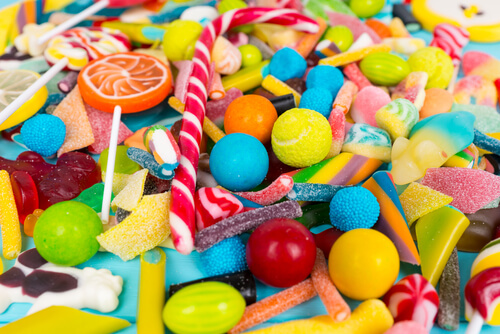Sugar Consumption in Children: Is There a Limit?

Sugar is very important in children’s diet since it provides energy they need throughout the day. However, excessive sugar consumption may trigger diseases in the long run.
Sugar consumption in children is essential since sucrose or glucose provides energy to the body and the mind. But there must be a limit when it comes to how much they can consume, right?
Well, yes. Children should consume only the necessary amount in order to grow, without the risk of diseases or dental decay.
During the first months of life, children consume sugar through milk (formula or breast milk). In fact, breast milk contains enough water, fat, protein, and sugar for babies to grow with the right nutritional values.
How much sugar should children consume?
As children grow, their diet varies. They begin to eat foods with different flavors and nutritional contributions.
These foods must guarantee the essential caloric and nutrient balance to allow children to maintain a healthy body weight and develop properly.
However, children shouldn’t consume sugar (other than the one found in milk) until they turn 2 years of age. Then, until they turn 5 years old, they can consume up to 15 grams of sugar a day.
From 4–14 years of age, the limit goes up to 25 grams a day. The World Health Organization establishes that sugar consumption in children shouldn’t account for more than 10% of their daily calories. This equals a maximum of six teaspoons per day.

Risks of excessive sugar consumption in children
Although sugar is necessary, no one should be dependent on it. It’s true that it provides energy, good brain health, and it helps to metabolize fats.
Preferably, it should be obtained through natural sources and in moderation. We must make an effort to leave out all sugary drinks and sweets.
Minimizing the consumption of processed sugar will prevent disorders and other health problems in children such as obesity, diabetes, and cardiovascular problems.
According to the World Health Organization, in the year 2016, there were more than 340 million children and teenagers between 5 and 19 years of age, who were overweight or obese.
When consumed excessively, it raises the cholesterol levels, triglycerides, blood pressure, and causes damage to the pancreas. Although sometimes it might cease our hunger momentarily, it could trigger diverse pathologies in the long run like hyperactivity, anxiety, and depression.
Natural sugar: the best one!
Glucose is an essential monosaccharide or a simple carbohydrate that’s contained in sucrose or sugar. When we consume it, it goes directly to our bloodstream and stays there.
Then, it reaches the liver to produce energy, and the excess is stored in the form of fat. Hence, the importance of avoiding consuming it more than we should.
The good kind of sugar
Sugar is usually related to natural and refined foods. Its good nutrients can usually be found in dairy products, in the form of lactose, also in fruits, fresh vegetables, and honey, in the form of fructose. In these cases, there’s no limit on the intake.
Honey and maple syrup are natural sugars. There are also other sugars you may know about, which are stevia and thaumatin. Artificial sugars (or modified sugars, as some call it) are contained in saccharin, cyclamate, aspartame, etc.
It can be found in different foods. Cane sugar or the one found in fruit provide calories in the form of carbohydrates. However, the way we metabolize them is completely different.
The bad or unhealthy kind of sugar
As parents, we must control the consumption of refined or processed sugars in our children.
Sweets or sugary drinks contain complex sugar, which comes from the union of several molecules that make up the starch. When our children consume these excessively, they put their health at risk and can trigger diseases, which is why it’s our duty as parents to be in control of this situation.
Sugar in industrialized foods
It’s difficult to determine the amount of sugar that a person can ingest almost without realizing it. Not knowing the real composition of the meals we consume increases the risk of ingesting large amounts of glucose.
To get the right information, it’s important to read the labels of processed foods before consuming them. Pay attention, though, because this information isn’t always clear or visible.
More often than not, 80% of the sugar that we ingest comes from industrialized foods. We might not realize it because some of them are labeled as healthy and harmless, which is why the point above is extremely important.

Tables of nutritional content are helpful
Nutritional tables allow us to see the number of fats and sugars that are included in a product so we can control the calories we consume. Paying attention to these labels is highly beneficial, especially when it comes to taking care of children’s health.
Being aware of the recommended amount of sugar consumption in children is essential. This will allow us to provide a balanced contribution of the nutrients that their body requires for proper development. Also, taking care of ourselves and our health will serve as an example for them.
Sugar is very important in children’s diet since it provides energy they need throughout the day. However, excessive sugar consumption may trigger diseases in the long run.
Sugar consumption in children is essential since sucrose or glucose provides energy to the body and the mind. But there must be a limit when it comes to how much they can consume, right?
Well, yes. Children should consume only the necessary amount in order to grow, without the risk of diseases or dental decay.
During the first months of life, children consume sugar through milk (formula or breast milk). In fact, breast milk contains enough water, fat, protein, and sugar for babies to grow with the right nutritional values.
How much sugar should children consume?
As children grow, their diet varies. They begin to eat foods with different flavors and nutritional contributions.
These foods must guarantee the essential caloric and nutrient balance to allow children to maintain a healthy body weight and develop properly.
However, children shouldn’t consume sugar (other than the one found in milk) until they turn 2 years of age. Then, until they turn 5 years old, they can consume up to 15 grams of sugar a day.
From 4–14 years of age, the limit goes up to 25 grams a day. The World Health Organization establishes that sugar consumption in children shouldn’t account for more than 10% of their daily calories. This equals a maximum of six teaspoons per day.

Risks of excessive sugar consumption in children
Although sugar is necessary, no one should be dependent on it. It’s true that it provides energy, good brain health, and it helps to metabolize fats.
Preferably, it should be obtained through natural sources and in moderation. We must make an effort to leave out all sugary drinks and sweets.
Minimizing the consumption of processed sugar will prevent disorders and other health problems in children such as obesity, diabetes, and cardiovascular problems.
According to the World Health Organization, in the year 2016, there were more than 340 million children and teenagers between 5 and 19 years of age, who were overweight or obese.
When consumed excessively, it raises the cholesterol levels, triglycerides, blood pressure, and causes damage to the pancreas. Although sometimes it might cease our hunger momentarily, it could trigger diverse pathologies in the long run like hyperactivity, anxiety, and depression.
Natural sugar: the best one!
Glucose is an essential monosaccharide or a simple carbohydrate that’s contained in sucrose or sugar. When we consume it, it goes directly to our bloodstream and stays there.
Then, it reaches the liver to produce energy, and the excess is stored in the form of fat. Hence, the importance of avoiding consuming it more than we should.
The good kind of sugar
Sugar is usually related to natural and refined foods. Its good nutrients can usually be found in dairy products, in the form of lactose, also in fruits, fresh vegetables, and honey, in the form of fructose. In these cases, there’s no limit on the intake.
Honey and maple syrup are natural sugars. There are also other sugars you may know about, which are stevia and thaumatin. Artificial sugars (or modified sugars, as some call it) are contained in saccharin, cyclamate, aspartame, etc.
It can be found in different foods. Cane sugar or the one found in fruit provide calories in the form of carbohydrates. However, the way we metabolize them is completely different.
The bad or unhealthy kind of sugar
As parents, we must control the consumption of refined or processed sugars in our children.
Sweets or sugary drinks contain complex sugar, which comes from the union of several molecules that make up the starch. When our children consume these excessively, they put their health at risk and can trigger diseases, which is why it’s our duty as parents to be in control of this situation.
Sugar in industrialized foods
It’s difficult to determine the amount of sugar that a person can ingest almost without realizing it. Not knowing the real composition of the meals we consume increases the risk of ingesting large amounts of glucose.
To get the right information, it’s important to read the labels of processed foods before consuming them. Pay attention, though, because this information isn’t always clear or visible.
More often than not, 80% of the sugar that we ingest comes from industrialized foods. We might not realize it because some of them are labeled as healthy and harmless, which is why the point above is extremely important.

Tables of nutritional content are helpful
Nutritional tables allow us to see the number of fats and sugars that are included in a product so we can control the calories we consume. Paying attention to these labels is highly beneficial, especially when it comes to taking care of children’s health.
Being aware of the recommended amount of sugar consumption in children is essential. This will allow us to provide a balanced contribution of the nutrients that their body requires for proper development. Also, taking care of ourselves and our health will serve as an example for them.
All cited sources were thoroughly reviewed by our team to ensure their quality, reliability, currency, and validity. The bibliography of this article was considered reliable and of academic or scientific accuracy.
- Hennet T., Weiss A., Borsing L., Decoding breast milk oligosaccharides. Swiss Med Wkly, 2014.
- Stanhope KL., Sugar consumption, metabolic disease and obesity: the state of the controversy. Crit Rev Clin Lab Sci, 2016. 53 81): 52-67.
This text is provided for informational purposes only and does not replace consultation with a professional. If in doubt, consult your specialist.








